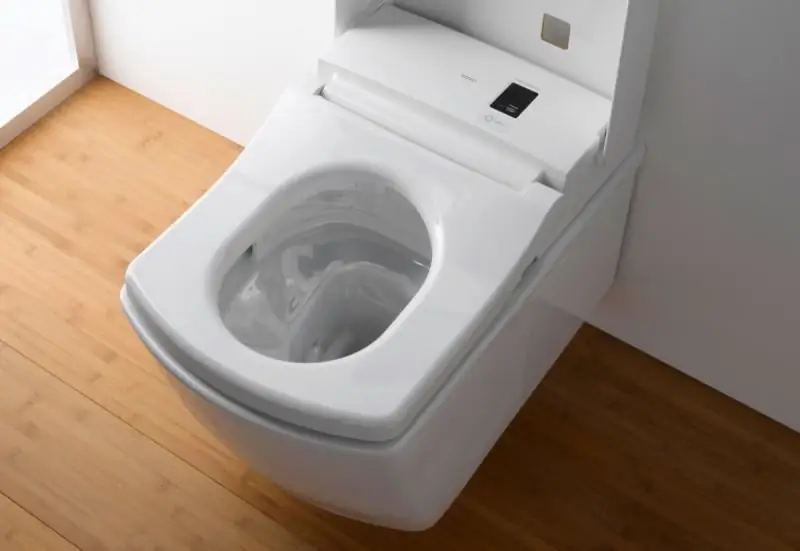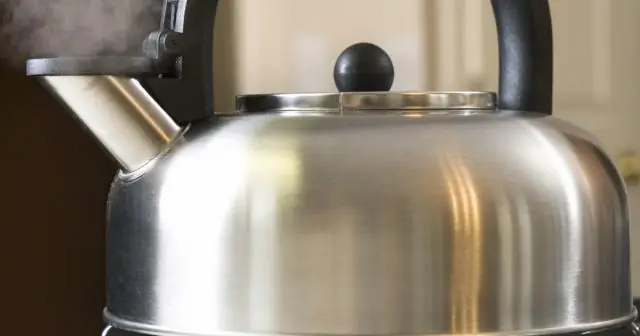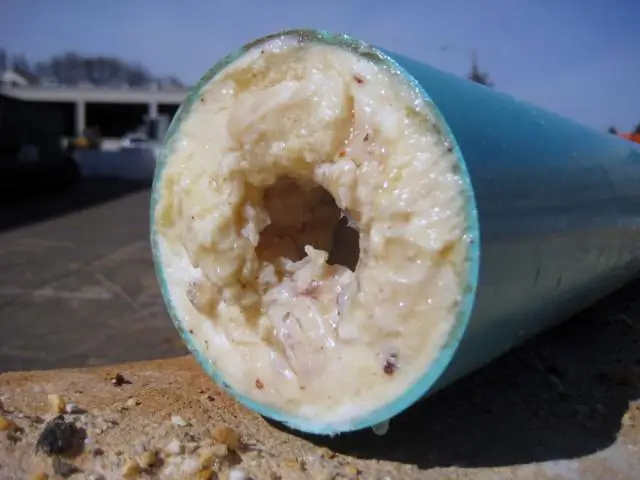
Table of contents:
- Author Bailey Albertson [email protected].
- Public 2023-12-17 12:53.
- Last modified 2025-06-01 07:32.
Hygiene issue: cleaning the toilet from urinary stones

There are rules in housekeeping that remain unchanged for many generations of housewives. A clean toilet is one of those. However, keeping your plumbing shiny is a bit of a hassle, even with the sheer number of cleaning products available on the market today. It is especially difficult to get rid of urinary calculus, which turns your toilet into a collection of mineral growths with a disgusting smell and gray-orange smudges on the surface of the sanitary ware. How to clean it at home?
Content
- 1 Where does urinary stone come from in the toilet
-
2 How to clean urinary stones inside the toilet at home
- 2.1 Preparatory phase
-
2.2 Store tools
2.2.1 Table: the most effective industrial remedies for the removal of urinary stones
-
2.3 Tools at hand
- 2.3.1 First place - electrolyte for batteries
- 2.3.2 Second place - bleach
- 2.3.3 Third place - oxalic acid
- 2.3.4 Vinegar, soda and iodine
- 2.3.5 Anticalc
- 2.3.6 Citric acid
- 2.3.7 Coca-Cola and Sprite against urinary stones
- 2.3.8 Video: how to remove a urinary calculus with Pepsi
- 3 Prevention
Where does urinary stone come from in the toilet
Basically, this is a mineral deposit that forms on the walls of the toilet, under the rim and in the place of stagnant water due to the fact that drops of urine fall on the surface. Overgrowth of urinary stones occurs because
- after using the toilet, not everyone remembers about flushing (this problem is especially relevant for families with small children - babies often forget to flush after themselves);
- a leaking tank promotes the spread of mineral deposits;
- defective plumbing, for example, with an uneven, embossed surface, provokes the accumulation of microbes, dirt and plaque;
- the toilet is too old, which means it is prone to all kinds of damage.

The urinary stone is not easy to peel off
Such a stone is not only an aesthetic problem. The fact is that if you do not fight the build-up, then it can grow to the point that the opening of the toilet bowl and sewer pipes narrows. That is why you need to start fighting the stone immediately.
How to clean urinary stones inside the toilet at home
There are several options for removing urinary deposits from the toilet. First of all, this is a mechanical method: the stone is cleaned from the surface with a knife, metal brush or sandpaper. However, this option is only suitable for old toilets, that is, "when there is nothing left to lose": such treatment will surely leave scratches that will grow even stronger over time. So solutions remain for effective control. These must be acid-base compounds. These can be found in lines of professional cleaning products or you can make your own.
Preparatory stage
Regardless of the choice, the surface must be prepared for cleaning
Instructions:
- We drain the water from the toilet and scoop out the remains. It is convenient to use a bucket with a long handle for this. This is a very important point, since any cleaning agent will be much more effective if water does not interfere with its action.
- We put on gloves - acid-base solutions are very aggressive to the skin.
Store funds
Popular among consumers
- powders (abrasives) for cleaning - Pemolux, Komet;
- gels (they corrode the stone as much as possible due to the fact that they slowly flow down the walls) - Domestos, Dressing duck;
- creams (can be combined with powders) - Sif.

Industrial products are available in bottles with comfortable spouts that easily slip under the rim of the toilet
Experimentally, three leaders have been identified for removing stone from the drain, from under the rim and from the bottom of the toilet bowl.
Table: the most effective industrial remedies for urinary calculus removal
| Means | Benefits of using |
| Dressing duck | Hydrochloric acid, which is part of the product, works in stagnant water, that is, in a drain. |
| Domestos | A special product - Domestos Pink (available in a black bottle), which works even on strong growths. |
| Mister Muscle Granules | A pipe cleaner can help remove stubborn stone from the bottom of the toilet. |
Before applying the product, you need to carefully study the instructions and follow them carefully (especially regarding the duration of action!), Otherwise you can damage the toilet bowl coating and the integrity of the pipes. And one more important nuance: after one cleaning it is hardly possible to get rid of urinary stones. So the procedure will have to be repeated several times, depending on the degree of neglect of the pollution, and then carry out regular preventive cleaning. By the way, the latter is relevant for any option for removing the build-up.
Improvised means
In the matter of cleaning the toilet bowl, the tools at hand can be called radical, since they are very effective, but require even more careful handling. So thick rubber gloves, a respirator (if possible) and a brush (just not necessarily metal!) Will be relevant. This is what the modern rating of the most effective and fastest ways to remove stone looks like.
First place - electrolyte for batteries
Please note that this method is only used if metal pipes are installed in the system, since plastic can be greatly affected by such cleaning
Instructions:
- After carrying out the preparatory procedures, pour a little electrolyte into the problem area.
- We leave for 1.5-2 hours.
- We clean off the plaque with a brush, wash off.

Electrolyte should not be used if there are plastic pipes in the house.
Second place - bleach
This type of cleaning has one indisputable advantage - after the procedure for removing the growths, the surface of the toilet bowl will dazzle with its whiteness.
Instructions:
- Pour a bag of bleach into the toilet.
- We leave the product overnight.
- We clean off the remnants of the build-up with a brush, wash off.
Please note that chlorine also neutralizes harmful bacteria. An alternative to packaged bleach is "Whiteness". Usually a standard bottle is used for one cleaning.

Whiteness and bleach cannot be used on colored enamel
The disadvantages of this method include the duration of exposure, as well as some inconvenience: it is very problematic to fill in bleach under the rim of the toilet bowl, so that remains "Whiteness".
Third place - oxalic acid
The white powder, available at hardware stores, works well for stubborn and stubborn urinary stones.
Instructions:
- Pour the acid into the drain (or use a cloth to "fix" the powder under the rim).
- We leave for 1-2 hours.
- We wash off, cleaning off the remnants with a brush.

Oxalic acid can be purchased at hardware stores
Vinegar, soda and iodine
This compound is easy to apply under the rim due to its consistency.
Instructions:
- Warm up a little 1 tbsp. 9% vinegar.
- Add 1 tbsp. l. baking soda and 1 tsp. iodine.
- Mix and pour into the toilet.
- We leave it overnight.
- We clean the surface with a brush, rinse off.
Anticalc

Descaler works well on small urinary calculus
Powder for removing scale, limescale, urinary calculus; sold in hardware stores. The application is the same as for bleach. Works well on not too old growths.
Lemon acid

For one cleaning you need 3-4 bags of citric acid
This is a good option to remove small build-ups; citric acid will be ineffective for old ones. But this way you can only remove the stone in the drain, but to clean the walls and rim, you will have to pick up something else.
Instructions:
- Pour 3-4 packets of lemon.
- We leave for 4-5 hours.
- We clean off the deposits with a brush, wash off.
Coca-Cola and Sprite against urinary stones
Carbonated beverages such as Cola, Sprite or Fanta are based on their high citric acid content. Pour 2-3 bottles of drink into the toilet, leave for 2-3 hours, clean off the plaque and rinse.

To clean, you will need to keep the drink in the toilet for about 2-3 hours
Video: how to remove urinary calculus using Pepsi
Prevention
So that you do not need to look for funds to combat old deposits, it makes sense to attend to weekly prevention.

Weekly cleaning will protect the toilet from the formation and growth of urinary stones
In order to negate the chances of formation of deposits in the toilet, you can use
- tablets that are placed in the flush tank - fight against growths under the rim;
- gel blocks, which are fixed under the rim - prevent the growth of stone in the drain.
In addition, it is worth remembering about the weekly cleaning of the "white friend", as well as the need to maintain the drain in working order, that is, to prevent leakage in a timely manner. And, of course, you should not clean the plumbing with metal brushes or pour hot food into the toilet - all this provokes the formation of microcracks, from which it is very difficult to completely clean the urinary stone. Another important preventive measure is the absence of urine stagnation, that is, it must be flushed off after each trip to the toilet.
You can cleanse the "white friend" from urinary stones at home. True, you must definitely take into account that acid and alkali should not be rashly poured into the toilet if the pipes in the house are plastic. In this case, it is better to use more gentle cleaning methods: soda, anti-calcium, etc., or use professional products for the care of plumbing fixtures.
Recommended:
How To Clean A Burnt Stainless Steel Pan, How To Clean Inside And Outside At Home

Information on how to clean a stainless steel pot using available tools. Traditional methods of getting rid of soot, fat, burnt food, water stains
Blockage In Pipes: Elimination At Home, How To Clean The Sewer, The Use Of Folk Remedies

Causes of blockage in pipes, ways to eliminate it, prevention tips and a video with a test of the effectiveness of ways to clean the sewer at home
Baby Heels: How To Clean At Home, Including Folk Remedies

How to exfoliate your feet. Professional, folk and mechanical methods. What can not be treated with feet
How To Clean The Chimney From Soot, Including Folk Remedies, As Well As A Cleaning Tool

How to clean a chimney without the help of a chimney sweep with your own hands. What materials to choose. What are chemical and folk methods for cleaning the chimney from carbon deposits
How To Remove Fat From The Legs At Home: Exercise, Folk And Other Remedies, Reviews

Why is fat deposited on the frogs. How to remove it at home. Features of diet, exercise, beneficial procedures
